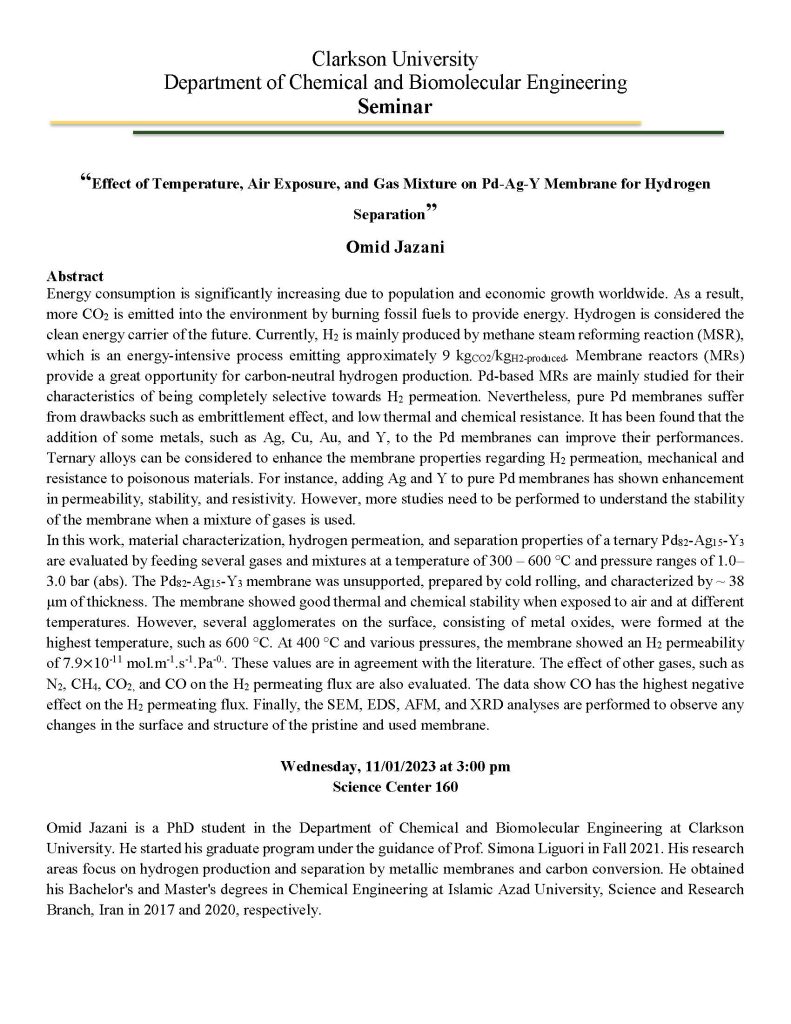
Department of Chemical and Biomolecular Engineering
Seminar
“Effect of Temperature, Air Exposure, and Gas Mixture on Pd-Ag-Y Membrane
for Hydrogen Separation”
Omid Jazani
Abstract
Energy consumption is significantly increasing due to population and economic growth worldwide. As a result, more CO 2 is emitted into the environment by burning fossil fuels to provide energy. Hydrogen is considered the clean energy carrier of the future. Currently, H 2 is mainly produced by methane steam reforming reaction (MSR), which is an energy-intensive process emitting approximately 9 kg CO2 /kg H2-produced . Membrane reactors (MRs) provide a great opportunity for carbon-neutral hydrogen production. Pd-based MRs are mainly studied for their characteristics of being completely selective towards H 2 permeation. Nevertheless, pure Pd membranes
suffer from drawbacks such as embrittlement effect, and low thermal and chemical resistance. It has been found that the addition of some metals, such as Ag, Cu, Au, and Y, to the Pd membranes can improve their performances. Ternary alloys can be considered to enhance the membrane properties regarding H 2 permeation, mechanical and resistance to poisonous materials. For instance, adding Ag and Y to pure Pd membranes has shown enhancement in permeability, stability, and resistivity. However, more studies need to be performed to understand the stability of the membrane when a mixture of gases is used. In this work, material characterization, hydrogen permeation, and separation properties of a ternary Pd 82 -Ag 15 -Y 3 are evaluated by feeding several gases and mixtures at a temperature of 300 – 600 °C and pressure ranges of 1.0–3.0 bar (abs). The Pd 82 -Ag 15 -Y 3 membrane was unsupported, prepared by cold rolling, and characterized by ~ 38 μm of thickness. The membrane showed good thermal and chemical stability when exposed to air and at
different temperatures. However, several agglomerates on the surface, consisting of metal oxides, were formed at the highest temperature, such as 600 °C. At 400 °C and various pressures, the membrane showed an H 2 permeability of 7.910 -11 mol.m -1 .s -1 .Pa -0. . These values are in agreement with the literature. The effect of other gases, such as N 2 , CH 4 , CO 2, and CO on the H 2 permeating flux are also evaluated. The data show CO has the highest negative effect on the H 2 permeating flux. Finally, the SEM, EDS, AFM, and XRD analyses are performed to observe any changes in the surface and structure of the pristine and used membrane.
Wednesday, 11/01/2023 at 3:00 pm
Science Center 160
Omid Jazani is a PhD student in the Department of Chemical and Biomolecular Engineering at Clarkson University. He started his graduate program under the guidance of Prof. Simona Liguori in Fall 2021. His research areas focus on hydrogen production and separation by metallic membranes and carbon conversion. He obtained his Bachelor’s and Master’s degrees in Chemical Engineering at Islamic Azad University, Science and Research Branch, Iran in 2017 and 2020, respectively.